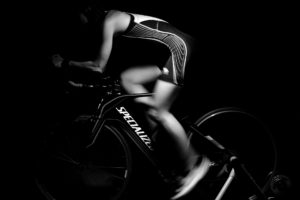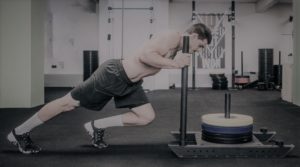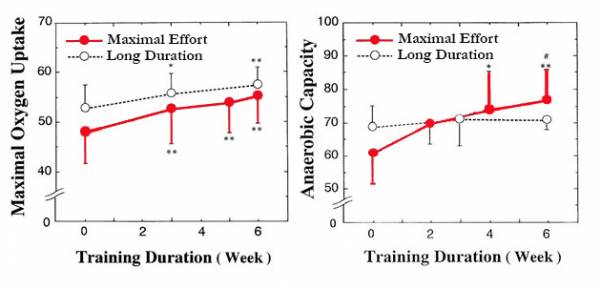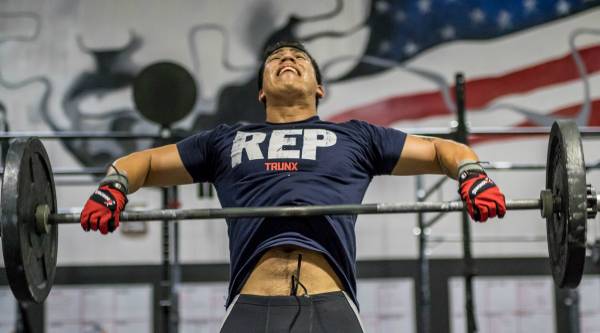Your feelings don’t matter! That is, your subjective feeling of the effectiveness of a workout is not important as what science tells us is important to building an impressive base of endurance and changing your body composition. A common training method is high-intensity interval training (HIIT).
This type of training leaves people on the floor in a pool of sweat feeling as if they have accomplished a great workout. In this article, I propose a smarter way of training, which should have a greater effect on endurance and long-term body composition effects. This high-intensity repeat training (HIRT) may not ‘feel’ as good, but your feelings don’t matter.
History of HIIT
Interval training with high intensities has been around for years. The tipping point of HIIT seems to have come with the research of Dr. Izumi Tabata. In the early 1990s, he collaborated with Irisawa Koichi, the Japanese speed skating team coach who had developed a protocol of short maximum bursts of sprints followed by short periods of rest. These short maximum burst improved and maintained peak performance in elite speed skating athletes. Tabata wanted to test the protocol with athletes at different levels.
The initial Tabata paper from 1996 examined two groups of amateur athletic males in their mid-twenties:
- The first group pedaled on an ergometer for sixty minutes at moderate intensity (70% of VO2 max). Similar to a long jogging session or what has been termed long slow distance (LSD) work.
- The second group pedaled for 20 seconds, followed by 10 seconds of rest, for 4 minutes (completing 7 to 8 sets total) at maximal effort. The key phrase is maximal effort, as each interval was expected to be a sprint. If athletes could not keep up the speed requirements, they were stopped at 7 sets.
Both groups trained for 5 days a week for a grand total of 5 hours a week or 20 minutes. The protocol lasted for 6 weeks.
In the above figure, the graph on the right shows anaerobic progress. As expected, the Tabata-style sprinting group improved their performance while the long-duration group did not. These results make sense given that the sprints use a lot more anaerobic processes.
The graph on the left shows the results of oxygen uptake, which is a measure of how efficient people are at aerobic activities (the more oxygen we can take in, the more efficient our aerobic processes will be). Both groups improved on this measure in similar fashions (the red line shows the Tabata-style maximal-effort group).
This result was expected for the long-duration group as they were specifically training for this goal. The result for the group doing sprints was surprising in that they improved in a similar fashion. Thus, it seems that a four-minute maximal intensity Tabata workout had the same aerobic benefits as doing a sixty-minute moderate intensity workout. This news was pretty shocking in that you could get two-in-one benefits from only a four-minute workout. The HIIT revolution had begun.

Tabata Velergometer
Potential Issues with HIIT
Maximal-effort sprint-like activities are a key component for Tabata workouts. Many people have difficulties maintaining maximum effort for 20 seconds over seven series. Thus, very few people actually do a Tabata style workout. There are many “Tabata-inspired” workouts that last from 20 minutes to 60 minutes. These bastardizations of Tabata protocols often lead to decreased effort on each interval.
Tabata style protocols have been shown to be beneficial in the short-term. The high stress on the body can cause it to adapt by getting rid of poorly functioning mitochondria (mitophagy) and replacing them. Issues arise when people attempt it for long periods of time. The high stress from these workouts can have detrimental effects in the long-term with degradation of mitochondria. Too much of a good thing becomes a bad thing (Ramos-Filho 2015).

Burgomaster and Gibala Intervals
Kirsten Burgomaster and Martin Gibala have modified Tabata’s maximal effort protocols. The big difference in their protocols from Tabata is that they allow for longer rest (4 minutes), but also longer work intervals (30 seconds of maximum effort).
Similar to Tabata’s original research, Burgomaster and Gibala have found benefits to aerobic and anaerobic systems. Others have found benefits in fat loss (here is a good review article). Four minutes of rest allows for more time for our ATP and creatine phosphate system to recover and may provide better performance on the maximal effort attempts.
A major benefit of Burgomaster and Gibala intervals is that it activates the AMPK pathway that is responsible for mitochondrial enhancement. In a nutshell, when we quickly deplete our ATP stores, we create ADP and AMP (each iteration having one less phosphate molecule; from triphosphate to diphosphate, to monophosphate). Our body uses the ATP/AMP ratio to signal AMPK, which then leads to more mitochondria to process the extreme energy demands5.
ATP -> ADP + energy -> AMP + energy
A single 30-second sprint increases the AMP/ATP ratio by as much as 21 times. However, we are walking a fine line between mitochondrial growth and ripping out the framework of our energy system. Once we get down to AMP, we can rip off the last phosphate and the whole structure breaks apart. We no longer have a structure to add phosphates.
Some of the biggest damage from a heart attack comes after oxygen returns to the heart (Emerling, 2009). The heart has used up all of the phosphate and the mitochondria start making free radicals as there are not enough adenosine ribose frames to accept phosphate molecules. With too long of intense training, we actually start making ammonia as the AMP molecule is broken down.
Timing is important. The longer rest of Gibala and Brugomaster’s protocols is nice, but for some athletes, we might be causing too much damage to the adenosine molecules going for 30-second intervals. We might improve upon these protocols by shortening the work intervals, which allows us to recover quicker and to not bring about as much lactic acid.
High-Intensity Repeat Training (HIRT)
Interval training is differentiated from repeats by when the recovery occurs. In interval training, the recovery is incomplete, so the next interval starts when the person is already fatigued. This incomplete recovery leads to a decline in performance after each interval. Repeats maintain the same high level of performance over time. Gibala and Burgomaster’s work would likely qualify as repeats as participants recover enough between sets to do the training again.
HIRT reduces long-term stress on the body that comes from HIIT training. The key component of HIRT is to maintain effort and power on each and every repeat. Charlie Francis, coach to many Olympic world-record holding sprinters, was known to maximize rest intervals so each sprint could be better or at least the same as the sprint before. Rest was vital so that people could ‘repeat’ their performance, not watch it degrade.
The important part of repeat training is to be able to perform at maximal intensity each time. Another example is to work around 10 seconds or less, so that recovery can occur much quicker. An example would be doing ten kettlebell swings every minute on the minute for about 10 minutes. The key is to have maximum power on each and every set. A potential way to make sure one is maximizing power is to use an accelerometer.
Summary
There are some key components to HIRT:
- The first component is built right into high-intensity repeat training name. The person must be able to repeat the high-intensity performance. If it can’t be repeated, then the training session should end or more rest is needed.
- Intensity is key. The goal is to practice the exercises with maximal intensity for a short duration of time. Don’t worry about your feelings of guilt for not training longer. Doing more than the specified sets will not help you in the long run.
- Work duration should be between 5 to 15 seconds. Longer time intervals will lead to decreased performance and the need for longer rest (Gibala needs 4 minutes of rest for 30 seconds of work). Keeping the work time short allows for maximum effort and quicker repeat performance.
- Luxurious rest intervals are needed. For 10 seconds of work, there should be about 45 seconds of rest. Training in every minute on the minute fashion works well for 10 seconds of intense work.
- Pick exercises with less risk of injury and the ability to maintain maximum power. Sprinting form is a difficulty for many people. Furthermore, the power in a sprint can only be maximized for the first few seconds of the sprint (then the maintenance or stopping of deceleration is what is important). Sled pushes or pedaling an exercise bike are better and probably safer for a sedentary athlete. Rowers or swimming are also good alternatives. For advanced athletes with the ability to swing or snatch a kettlebell explosively, the snatch and swing work well. The key is the ability to do it with maximum power.
- Volume varies depending on goals. If your goal is maximal strength, then doing HIRT workout one to two times a week might be beneficial. If your goal is to build greater endurance, then four to five days a week will be most beneficial.
- Separate strength from conditioning. Do not think HIRT as a way to build strength. You must be strong first.
A Sample Protocol
Combining the above components we can create an example protocol. Load a sled so that you can move fast (hill sprints would work too). Sprint for 8 seconds as far as possible. Measure the distance after each push and maintain it. Do one set every minute for 4 to 10 sets (vary the volume each session by doing low medium and high volume days). If you can’t maintain the distance, the training session is complete and you need to add more rest to your next training session.

References:
1. Boutcher, S. H. (2010). “High-Intensity Intermittent Exercise and Fat Loss.” Journal of Obesity, 2011, e868305. doi:10.1155/2011/868305
2. Burgomaster, K. A., Heigenhauser, G. J., & Gibala, M. J. (2006). “Effect of short-term sprint interval training on human skeletal muscle carbohydrate metabolism during exercise and time-trial performance.” Journal of Applied Physiology, 100 (6), 2041–2047.
3. Burgomaster, K. A., Howarth, K. R., Phillips, S. M., Rakobowchuk, M., MacDonald, M. J., McGee, S. L., & Gibala, M. J. (2008). “Similar metabolic adaptations during exercise after low volume sprint interval and traditional endurance training in humans.” The Journal of Physiology, 586(1), 151–160.
4. Emerling, B. M., Weinberg, F., Snyder, C., Burgess, Z., Mutlu, G. M., Viollet, B., … Chandel, N. S. (2009). Hypoxic activation of AMPK is dependent on mitochondrial ROS but independent of an increase in AMP/ATP ratio. Free Radical Biology and Medicine, 46(10), 1386–1391.
5. Hardie, D. G. (2003). Minireview: The AMP-Activated Protein Kinase Cascade: The Key Sensor of Cellular Energy Status. Endocrinology, 144(12), 5179–5183.
6. Hardie, D. G., Ross, F. A., & Hawley, S. A. (2012). AMPK: a nutrient and energy sensor that maintains energy homeostasis. Nature Reviews Molecular Cell Biology, 13(4), 251–262.
7. Gibala, M. J., Little, J. P., Van Essen, M., Wilkin, G. P., Burgomaster, K. A., Safdar, A., … Tarnopolsky, M. A. (2006). “Short-term sprint interval versus traditional endurance training: similar initial adaptations in human skeletal muscle and exercise performance.” The Journal of Physiology, 575(3), 901–911.
8. Kahn, B. B., Alquier, T., Carling, D., & Hardie, D. G. (2005). AMP-activated protein kinase: Ancient energy gauge provides clues to modern understanding of metabolism. Cell Metabolism, 1(1), 15–25.
9. Medbo, J. I., & Tabata, I. (1989). “Relative importance of aerobic and anaerobic energy release during short-lasting exhausting bicycle exercise.” Journal of Applied Physiology, 67(5), 1881–1886.
10. Ramos-Filho, D., Chicaybam, G., de-Souza-Ferreira, E., Martinez, C. G., Kurtenbach, E., Casimiro-Lopes, G., & Galina, A. (2015). High Intensity Interval Training (HIIT) Induces Specific Changes in Respiration and Electron Leakage in the Mitochondria of Different Rat Skeletal Muscles. PLOS ONE, 10(6), e0131766.
11. Tabata, I., Irisawa, K., Kouzaki, M., Nishimura, K., Ogita, F., & Miyachi, M. (1997). “Metabolic profile of high intensity intermittent exercises.” Medicine and Science in Sports and Exercise, 29(3), 390–395.
12. Tabata, I., Nishimura, K., Kouzaki, M., Hirai, Y., Ogita, F., Miyachi, M., & Yamamoto, K. (1996). “Effects of moderate-intensity endurance and high-intensity intermittent training on anaerobic capacity and VO2max.” Medicine and Science in Sports and Exercise, 28(10), 1327–1330.






